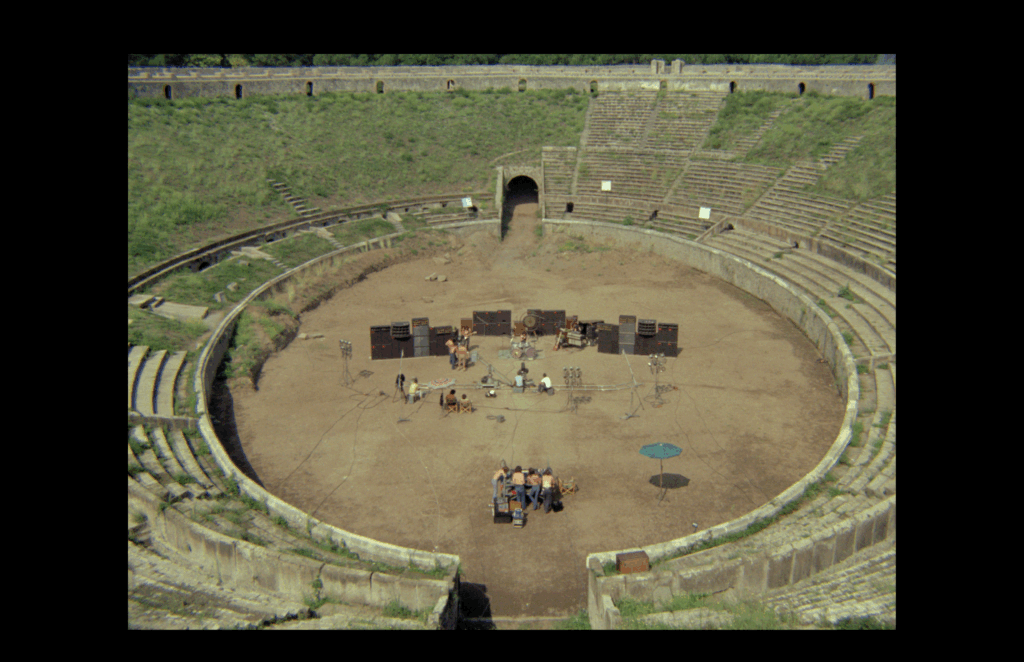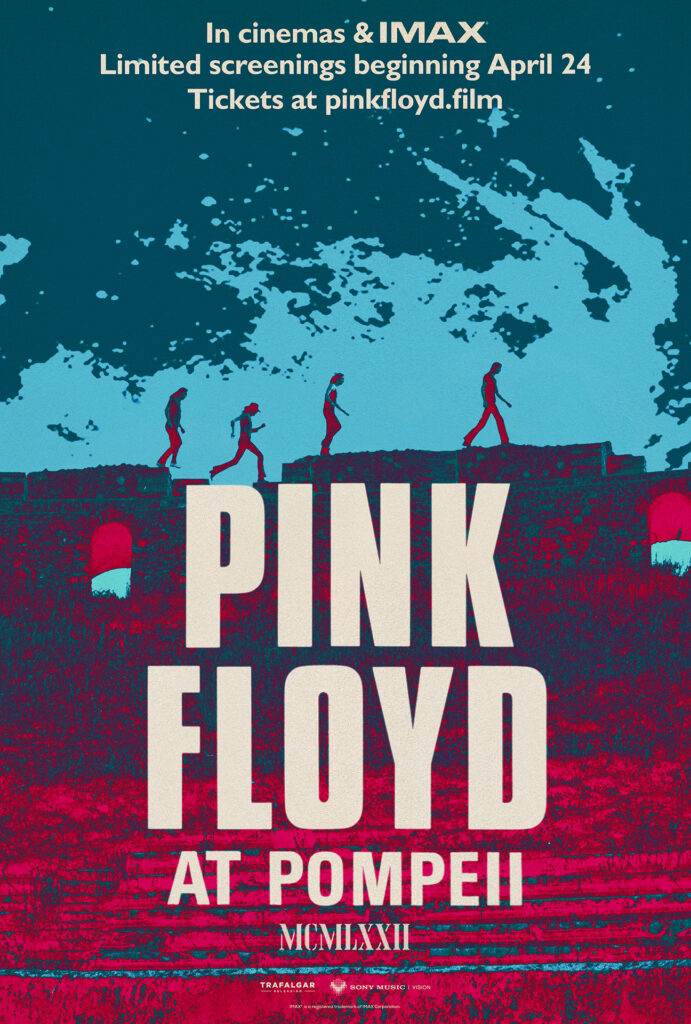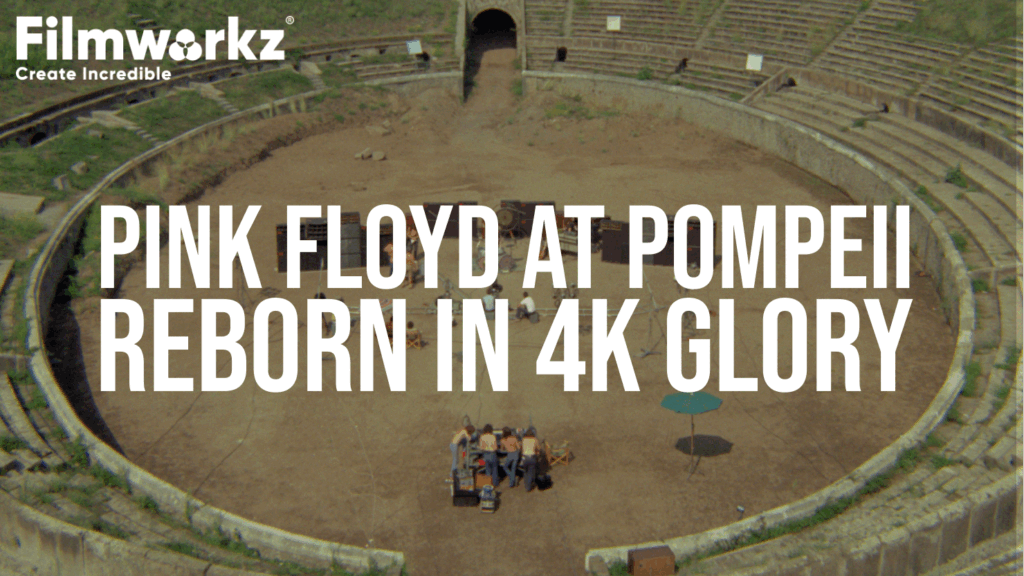In October 1971, among the crumbling stone of an ancient Roman amphitheatre, something extraordinary happened. Pink Floyd, then a rising force in progressive rock, performed an uninterrupted, audience-free set in the stillness of Pompeii’s ruins. The resulting film, Pink Floyd: Live at Pompeii, directed by Adrian Maben, became a time capsule: part rock documentary, part experimental art, and wholly iconic.
Over 50 years later, this legendary performance has been digitally remastered in 4K from the original 35mm footage, brought back to life by the team at FilmFinity using the powerful restoration tools inside Filmworkz’s Phoenix software. The restored film returns to cinemas this April, including special screenings at the BFI IMAX, the UK’s largest screen, offering a truly epic experience for both long-time fans and new audiences.

‘I’m thrilled that the BFI IMAX is leading the UK and often the global box office with so many reissues of music documentaries and can’t wait to have Pink Floyd Live at Pompeii – MCMLXXII back on theatrical screens after such a long time in archive. This is such good news for classic concerts and often ‘lost’ material to find its way back to the big screen for new and familiar audiences, ensuring historic material is persevered and brought back into the mainstream for everyone to enjoy. The option to see and hear this fantastic concert on IMAX will be mind-blowing, especially as the restoration process is handled so carefully and each frame is restored, each sound is remastered. So exciting and I hope everyone enjoys the screenings at the BFI IMAX.’ Madeline Mullet | BFI Imax Programme Manager
A Rock ‘n’ Roll Relic Worth Preserving
Pink Floyd’s performance at Pompeii was anything but typical, and that’s precisely why it continues to captivate. Without an audience, the film focuses purely on music and atmosphere. The amphitheater becomes a ghostly, majestic co-star to the band’s hypnotic sound. From Echoes to A Saucerful of Secrets and One of These Days, the film captures Pink Floyd at their most unfiltered and artistically ambitious.

The restoration project was led by Lana Topham, Director of Restoration for Pink Floyd, with one clear goal: “to preserve the integrity and beauty of the original picture.” But getting started was no simple task
“I already knew that half the cans found were optical sound reels, which are most susceptible to vinegar syndrome and ultimately none of it was usable. I also knew from experience that what a can says on the outside is often not what’s on the inside… that’s if there’s even a readable label on them… So, when Marie-Louise from Filmfinity identified five of the cans as containing the original first negative cut of the film from 1972, it’s safe to say I was both relieved and pretty excited!”
Clayton Baker, Head of Operations at FilmFinity, also knew this was no ordinary restoration.
“A key priority was staying true to director Adrian Maben’s original vision. Lana made sure the 4K restoration was preserved exactly as this first cut negative of the program came out of the cans.”
Restoration Powered by Phoenix
The hands-on restoration was led by Tom Barrett, FilmFinity’s Restoration Specialist, using Phoenix, Filmworkz’s industry-leading software renowned for its intelligent, frame-by-frame capabilities.

“Filmworkz’s Phoenix was integral to the restoration of Pink Floyd at Pompeii. As with most restoration, the first pass of semi-automatically removing film dust and dirt is one of the most important processes. For this, we turned to DVO Dry Clean,” says Tom Barrett.
Having collaborated with Lana on Pink Floyd projects for over 15 years, Tom considers DVO Dry Clean one of the most effective tools available.
“DVO Dry Clean has been the biggest and most impressive advancement in years. It makes a big difference and is a huge benefit and advantage over other restoration software dirt filters. And with a good dry clean pass, you can cut down on the amount of manual cleanup needed, which is always the most time-consuming part of the restoration process.”
Fortunately, the film itself had aged remarkably well. “In terms of shrinkage and physical degradation, the 35mm negative was in pretty good shape,” says Tom. But before the frame-by-frame work could begin, the negatives were scanned using ARRI technology.
“This was crucial for Pompeii,” adds Clayton. “The old film reels had picked up significant surface dirt and damage. Using this technology helped preserve fine image detail and reduced the amount of time needed for manual digital cleanup.”
From there, the real work began. The team used tools like DVO Clarity, particularly in the Abbey Road sequences and scenic shots where grain was heavier—alongside DVO Steady 2, DVO Scratch Target, DVO Flicker, and DVO Fix. The full 4K aperture was then framed for UHD in Phoenix to achieve the clean, sharp final look.
Out of all the sequences, one stood out to Tom: “A lot of time was put into the song Echoes Part 1, so it was great to see this sequence come up clean and look so good. Also, what a great song to see picture and audio working so well together!”
Reviving a Legend, Frame by Frame

A core principle for the team was maintaining the feel of Pompeii—the hazy heat of the Italian sun, the analog textures, the grain of 35mm film stock. These weren’t flaws to eliminate; they were essential to the film’s soul.
“Pink Floyd at Pompeii offers a captivating snapshot of the early ’70s and I’m proud to have played a part, along with my team, in bringing this definitive version to life,” says Lana.
The project also included audio enhancements, the music having been remixed by Steven Wilson from the original audio tapes, to offer a truly immersive experience that matches the visual restoration.
A Film That Transcends Time
Pompeii is more than a film. It’s proof that restoration isn’t just about fixing dust and scratches—it’s about honoring legacy. It gives historic moments the power to speak clearly to future generations.
“Live at Pompeii isn’t just a gig—it’s pure music history, a cultural high note. We’re beyond proud that Filmworkz tools helped bring it roaring back to life. Being part of restoring that legendary fusion of sound, vision, and raw energy is a real honor,” says Daniel Broch, Strategic Director of Filmworkz.
As Pompeii returns to the big screen, we’re reminded of why restoration matters— why the past deserves not just to be remembered, but to be seen in its full glory.
“This project really shows how powerful and rewarding it can be to re-experience iconic music performances in 4K with remastered sound,” says Clayton. “The stunning results of this restoration prove what’s possible using today’s cutting-edge techniques—bringing classic films back to life for both loyal fans and new audiences.”



